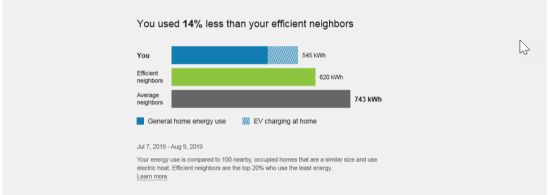Electric Vehicle Neighbor Comparison
The EV Neighbor Comparison compares the customer ("You") to two different groups: "Efficient Neighbors" and "Average Neighbors." The results are displayed in a horizontal bar graph. The "You" bar displays general home use and indicates what percentage of the home use was due to electric vehicle charging. A summary statement indicates how the customer compares to their efficient neighbors. "Efficient Neighbors" are defined as the most efficient 20% of the customer's neighbors. The comparison is designed to motivate customers to save energy based on how they see themselves in relation to their neighbors.

Normative Message / Insight Statement: The normative message appears above the chart and provides an insight
Bar Chart: The bar chart displays how much energy each group in the comparison used. The energy units displayed in the chart are based on the customer's fuel type. For example, kWh is shown for single fuel electric customers, and "units" is used for dual fuel customers since electricity and natural gas usage are combined into a single measurement.
- You: This bar indicates how the customer is doing. It displays general home use and indicates what percentage of the home use was due to electric vehicle charging.
- Average Neighbors: This bar indicates how all the customer's neighbors are doing. It is usually a gray or neutral color. The energy use data that is shown is the mean energy use value.
- Efficient Neighbors: This bar displays a usage value for the most efficient 20% of the customer's neighbors. The efficient neighbors value that appears in the module is not an average of the top 20% of neighbors. A threshold value—the 20th percentile neighbor—is used to determine the efficient neighbors value.
Dynamic Neighbor Description: The dynamic neighbor description summarizes the characteristics of the neighbors that the customer is compared to. This information helps assure customers that the comparison is fair and accurate. The description may include one or more of the following:
- Number of neighbors: The number of other homes that the customer is compared to.
- Proximity: The geographic proximity of the neighbor's homes rounded to the nearest whole unit.
- Home Size: The average home square footage among neighbors.
- Heat Type: The heating type of the neighbors, such as gas or electric heating.
Requirements and Limitrations
Fuel: Electric and dual fuel.
AMI Data Required: Hourly AMI and Appliance detection and disaggregation data.
Data History: A minimum of one historical bill.
Billing Frequency: Monthly, bi-monthly, quarterly.